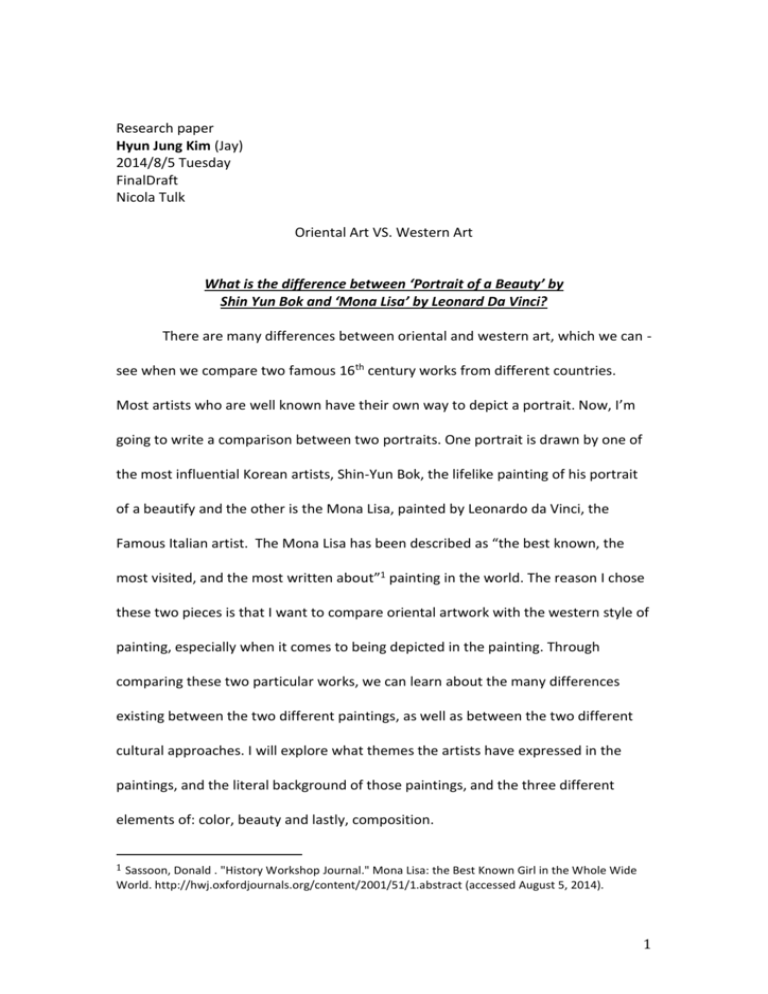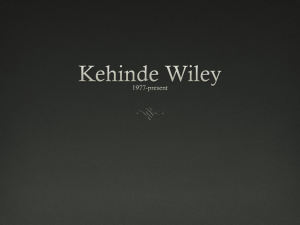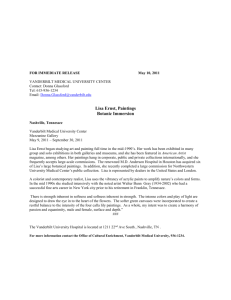Integrative Seminar 2 (Oriental Vs Western Art)
advertisement

Research paper Hyun Jung Kim (Jay) 2014/8/5 Tuesday FinalDraft Nicola Tulk Oriental Art VS. Western Art What is the difference between ‘Portrait of a Beauty’ by Shin Yun Bok and ‘Mona Lisa’ by Leonard Da Vinci? There are many differences between oriental and western art, which we can see when we compare two famous 16th century works from different countries. Most artists who are well known have their own way to depict a portrait. Now, I’m going to write a comparison between two portraits. One portrait is drawn by one of the most influential Korean artists, Shin-Yun Bok, the lifelike painting of his portrait of a beautify and the other is the Mona Lisa, painted by Leonardo da Vinci, the Famous Italian artist. The Mona Lisa has been described as “the best known, the most visited, and the most written about”1 painting in the world. The reason I chose these two pieces is that I want to compare oriental artwork with the western style of painting, especially when it comes to being depicted in the painting. Through comparing these two particular works, we can learn about the many differences existing between the two different paintings, as well as between the two different cultural approaches. I will explore what themes the artists have expressed in the paintings, and the literal background of those paintings, and the three different elements of: color, beauty and lastly, composition. 1 Sassoon, Donald . "History Workshop Journal." Mona Lisa: the Best Known Girl in the Whole Wide World. http://hwj.oxfordjournals.org/content/2001/51/1.abstract (accessed August 5, 2014). 1 Portrait of a Beauty by Shin Yun Bok contains limited colors Compared to the Mona Lisa portrait, Shin Yun Bok’s portrait uses fundamental color choices, such as Might night blue, red and Flavescent Yellow. The Colors really pop and they contrast well with one another. Da Vinci’s portrait uses earth tones, flesh tones, blues and greens in the painting. During Leonardo's time artists had their own formula for mixing paint. Used to paint the face are mostly warm colors such as, Amber yellows, Mustard oranges, Indian reds and the tones in between. Shin Yun Bok’s portrait was created in the middle of the Joseon dynasty (1637~1895) During the In Joseon Dynastic the mid –Joseon painting styles moved increasingly towards a Korean style, which in turn derived from the traditional Chinese style. The Mid-to-late Joseon dynasty is considered the best age of Korean painting. Korean artists had developed a number of different styles in the absence of Chinese cultural influence. Chinese art tends to use types of several of reds and yellows. It also uses many geometric designs. Koreans use less color, because they with natural resources. The one thing that usually stands out to me is that old Korean paintings seem to be more minimalist in nature. These paintings use fewer colors and a greater use of empty space. Chinese paintings can also be this way, but I notice that it's more predominant in older Korean art. So, at that time when Shin Yun Bok painted this portrait there were lots of limitations in using materials because at that time in the Joseon Dynasty artists were not given lots of interest and support by government. Things such as colors and applications for approaching a 2 new style were not easily equipped. The color palette that the Koreans had was very scarce, which meant they had fewer colors to select from. Leonardo da Vinci applied oil paint to his canvas to create the Mona Lisa. Leonardo da Vinci used earth tones, flesh tones and some dark color such as Royal blue, Navy blue and Rifle Dark Olive greens in the painting and by using these colors he gave his paintings a great artistic look . Originally the background has been applied with cool colors such Dark Olive green and Sapphire blue. However, over time the original color of the painting has faded. To depict the center, which is the Mona Lisa he applied ‘warm colors’ such as Peach, Pastel Orange and Bronze2. Shin Yun Bok mostly used a flat way to depict the portrait, in contrast Leonardo da Vinci took a special interest in finding ways to realistically render three-dimensional forms on a flat canvas. Shin Yun Bok, in contrast, drew on the top of silk using watercolor. Also, rather than using a brush, he mostly drew lines to express the feeling of the Korean traditional style of painting. Korean painting has been shown to create compositions with metaphoric meaning, intended to be viewed as colorful works of fine art. While Korean art was originally brought from China, both Chinese and Korean art are different in many ways. One of those ways are how the usage of patterns and repetition in Chinese art. Koreans painted in a simple way, but with that one simple object in the painting comes a lot of significance. Chinese art uses a lot of vibrant standard colors, like green, yellow, red, and blue. Korean art 2 Smith, Webster. "Observations on the Mona Lisa landscape." Art Bulletin 67, (June 1985): 183-199. Art Source, EBSCOhost(accessed July 25, 2014)(pg 194). 3 usually includes vibrant primary colors, but with different variations, like sky blue, or mustard yellow, or even olive greens. The art pieces I have been considering similar themes. In Shin Yun Bok’s “Portrait of Beauty” is a good example of how he represents in female representation by using a woman’s face in the cultures in mid-century Korea. Leonardo Da Vinci’s portrait represents a trend in Italy during his lifetime. We can see, for example, that Mona Lisa has no eyebrows. Shaving all eyebrows was a trend at that time when Da Vinci drew the portrait of this lady. Also, a wide forehead was a typical considered an emblem of beauty in Italy.3 The artists gave different meanings of beauty through their paintings. Shin Yun Bok mostly focuses on hair and clothes because in the Old century Korean culture was obligated to dress up very formally and neatly which is why you can see a woman in the painting with neat hair and a dress. Clothing was one of the ways to symbolize a time period. Applying clothing in the paintings was a great way to symbolize what the trend was at the time. It depicts what was the ideal standard of beauty during that Joseon Dynasty (1610-.1800) The most noticeable feature of the painting is the realistic detail of the Hanbok that the woman is wearing. Hanbok is the traditional Korean dress it is often characterized by vibrant colors and simple lines without pockets. The concept of making a woman the focus of a painting at the time was considered to be revolutionary because woman as a model in that time was not usual, (women were not treated equally with men) 4. Leonardo da Vinci cared for skin, face, and gesture. In all his works he usually 3 Smith, Webster. 1985. "Observations on the Mona Lisa landscape." Art Bulletin 67, 183-199. Art Source, EBSCOhost (accessed July 25, 2014). 4 Lee, Young-Jae. "Hong-Do Kim and Yun-Bok Shin: Comparative Analysis of Korean Genre Paintings." Arts Of Asia 37, no. (July 2007): 45-53. Art Source, EBSCOhost (accessed July 25, 2014). 4 depicted humans very precisely and frequently they are naked. Both women in the portraits were not based on a live model or if the painting was based off of a live model, it is still unknown to the world.5 The lady in the ‘Shin Yun Bok’ painting was based on a famous Korean prostitute and Mona Lisa was based off of beautiful traits that most women in Italy had. Despite the fact they were not depicting real faces of women, both artists well understood the trends of the time when they drew those pieces. Both works have a distinctive composition of balance. The Mona Lisa is mostly a balanced composition. Mona Lisa today and see it’s composition as standard and simple – for it’s time the composition of the Mona Lisa was innovation and ground breaking, also it has set new trends in painting which have been followed for centuries afterward. One of the compositional method that the portrait is known for is Leonardo’s using a pyramidal composition, which shows with her arms and hands forming a front corner and everything is in the place to draw the eye from her body to her eyes and her smile.6 I realized that there is many scientifically balance that was applied to this work and everything is mathematical designed and measured. Shin Yun Bok is known to used the traditional method of leaving empty space in his paintings, usually the whole canvas. Although he placed short verse and his seal on most of his works, indicate the date and time of their creation, is really difficult to find out also describe the process of making his painting. As one of the pillars of genre painting in the Joseon era, he influenced many other painters 5 Smith, Webster. 1985. "Observations on the Mona Lisa landscape." Art Bulletin 67, 183-199. Art Source, EBSCOhost (accessed July 25, 2014). (p.g 182) 6 "What the Mona Lisa Can Teach You About Taking Great Portraits - Digital Photography School." Digital Photography School RSS.. Web. 25 July 2014. 5 afterwards. Even though (artist) and (artist) have similar subjects in the two famous works discussed above, there are differences in balance, color and the reasons why they used and expressed their materials the way they did. During the Joseon dynasty, the Koreans were not as advanced as the Westerners in terms of colors. Koreans had a limited color palette, and had to start to discover how to mix new colors, while Westerners had already invented them. These two cultures come from two different worlds, with that said the concept of their art is entirely different. Westerners would focus more on the beauty of the features, and the body language of the portrait. While Asians would paint for more of a metaphorical purpose. Both Asian and Western cultures were similar when it came to the material they would use to paint their portraits. They would use cow, and horsetail hair to create their paintbrushes. While the Asians were quite abundant with the selection of their colors, the Westerners were very knowledable at selecting colors for their paintings. 6 Bibliography: Chicago citation Charney, Noah. 2011. "Lessons from the History of Art Crime "Mona Lisa Myths: Dispelling the Valfierno Con." Journal Of Art Crime no. 5: 55-56. Art Source, EBSCOhost (accessed August 5, 2014). FILIPCZAK, Z. Zaremba. 1977. "New light on Mona Lisa: Leonardo's optical knowledge and his choice of lightin." Art Bulletin 59, 518-523. Art Source, EBSCOhost (accessed August 5, 2014). Lee, Young-Jae. 2007. "Hong-Do Kim and Yun-Bok Shin: Comparative Analysis of Korean Genre Paintings." Arts Of Asia 37, no. 4: 45-53. Art Source, EBSCOhost (accessed August 5, 2014). "History of Chinese art." Princeton University. http://www.princeton.edu/~achaney/tmve/wiki100k/docs/History_of_Chinese_art.html (accessed August 5, 2014). Sassoon, Donald . "History Workshop Journal." Mona Lisa: the Best Known Girl in the Whole Wide World. http://hwj.oxfordjournals.org/content/2001/51/1.abstract (accessed August 5, 2014). 7









